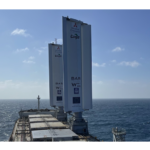
Energy savings of first WindWings vessel evaluated

BAR Technologies’ WindWings added to cargo ships can save 32 per cent energy, says a new report.
The performance of BAR Technologies’ WindWings has been validated by DNV. In an interim report, DNV found that when sailing in favourable conditions the two WindWings installed on the MV Pyxis Ocean, a Kamsarmax bulk carrier under management of MC Shipping Singapore Branch and chartered by Cargill, reduced energy consumption of the main engine by 32 per cent, per nautical mile.
In December last year, John Cooper CEO of BAR Technologies, told MIN that the performance had been better than even he expected. While Cooper says WindWings is marketed as a fuel saving of 1.5 tonnes for two wings, data had shown that the boat can save more (7.5 tonnes per day). “But, we don’t want to over promise and under deliver.
“We will still talk about 1.5 tonnes because it’s the average. The 7.5 could have been a really good wind, or really good wind direction – but we have achieved it over 24 hours. We also want to talk about a whole year over an average worldwide route rather than a small moment of time.”
The MV Pyxis Ocean is the world’s first ship to be equipped with the technology. It embarked on open waters in August 2023. During testing, between August 2023 and March 2024, the vessel traversed the Indian Ocean, Pacific Ocean, North and South Atlantic, and navigated Cape Horn and the Cape of Good Hope. So far, the ship has visited six ports completing eight successful loading and unloading operations.
“Innovative Wind Assisted Propulsion Systems (WAPS) like WindWings offer owners and operators new ways of saving energy and accelerating the decarbonisation of the maritime industry,” says Johanna Tranell, WAPS responsible, DNV Maritime Advisory. “At DNV we’re continually working to build trust in these new solutions and the best way to do that is to provide transparent, 3rd party, verified, insights into the real-world performance of these systems. This is why we’re so pleased to be working with future focussed companies like MC Shipping, Cargill, and BAR Technologies, to expand the industry knowledge base on WAPS. We look forward to building on this cooperation in the future.”
Karmesh Kumar Tiwari, deputy branch general manager, MC Shipping Singapore Branch, says: “The confirmation from DNV that WindWings are producing significant savings is a testament to the collective work of all involved and our efforts in advancing maritime fuel efficiency. This work underpins our strong commitment to integrating low carbon technologies to contribute decarbonisation in the maritime industry.”
Chris Hughes, decarbonisation specialist, Cargill, says that validation of the performance of the Pyxis Ocean against BAR’s simulation models has been one of the main goals from the outset of the project. “Having DNV involved to provide an independent perspective is an important step in that process, and this latest data builds upon the results that we shared earlier.”
According to BAR Technologies’ evaluation of the data in March 2023, energy savings from all tested conditions supports the company’s initial projections: average fuel savings of 1.5 tonnes, which is a reduction of over 5T CO2 emissions “well-to-wake”, per WindWing per day, across all global routes and seasons. In the future, Kamsarmax bulk carrier vessels, like the Pyxis Ocean, could carry three wings, further increasing the fuel savings and emissions reductions.
WindWings harness wind power to propel a ship forward, reducing the reliance on engines and fuel consumption. Controlled by a touch panel on the bridge, a simple traffic light system guides the crew in raising or lowering the wings. Once raised, the wings automatically adjust to the optimal configuration based on real-time wind measurements.
The post Energy savings of first WindWings vessel evaluated appeared first on Marine Industry News.
